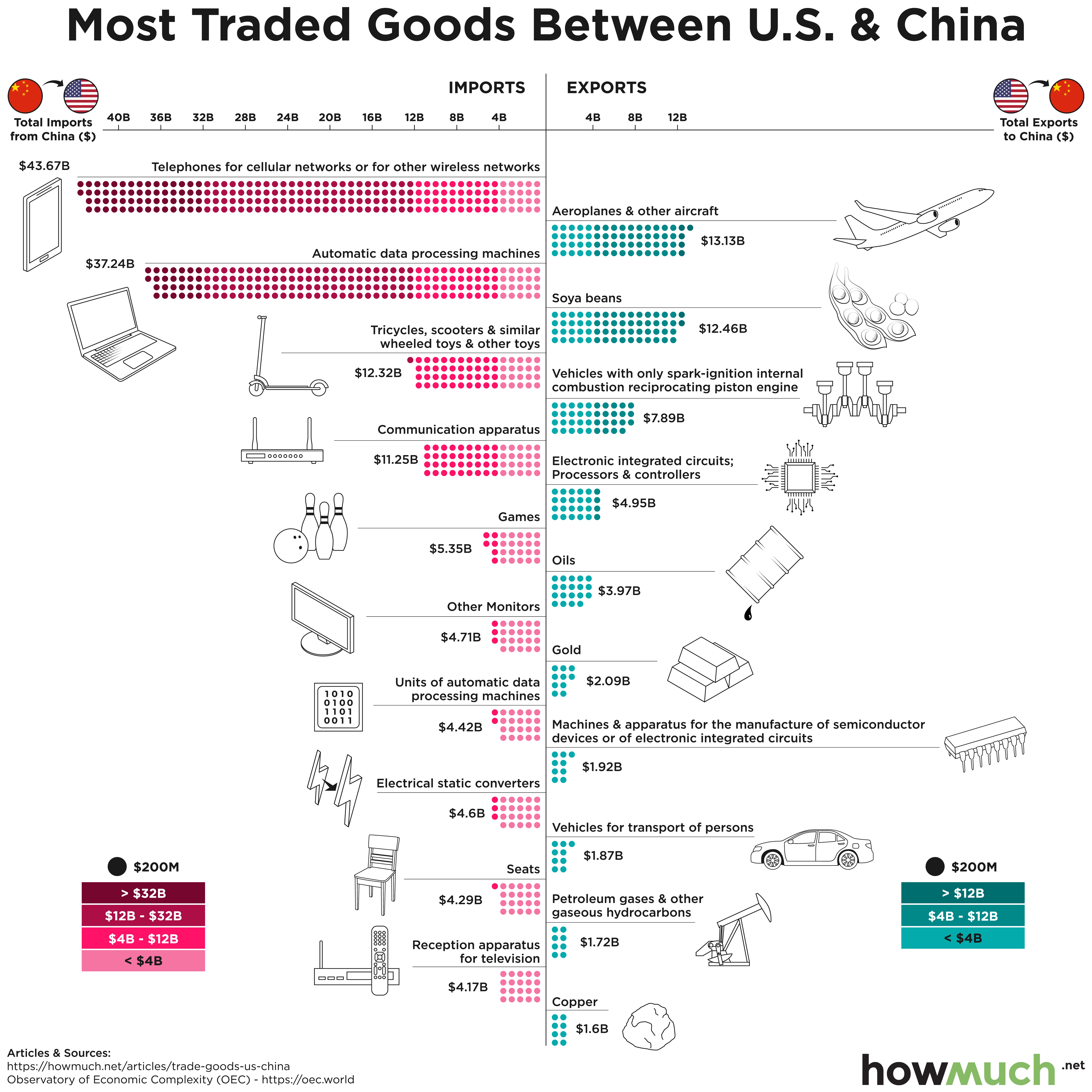Breaking The Trade Standoff: Examining The US And China's Concessions

Table of Contents
US Concessions: Tariff Reductions and Phase One Agreement
The US, under the Trump administration, initiated a series of tariffs on Chinese goods, prompting retaliatory measures from China. Subsequent negotiations led to the “Phase One” trade deal, which included significant US concessions.
Phased Tariff Rollbacks
The US implemented phased tariff rollbacks on various Chinese goods. This was a key concession aimed at de-escalating tensions and boosting US businesses.
- Before: Tariffs on certain goods reached as high as 25%, impacting sectors like technology and consumer electronics. For example, tariffs on certain types of smartphones reached 25%, impacting billions of dollars in imports.
- After: The Phase One deal saw reductions in tariff rates, though some tariffs remain in place. Specific reductions varied depending on the product category and the phase of the rollout. The impact on specific industries varied; some sectors experienced partial relief, while others saw minimal change.
- Affected Industries and Products: Agriculture (soybeans, pork), technology (semiconductors, telecommunications equipment), and consumer goods were among the most affected. The overall value of goods impacted by tariff reductions was substantial, with estimates reaching hundreds of billions of dollars annually.
- Conditions and Monitoring: These rollbacks were conditional, with ongoing monitoring and review mechanisms in place to ensure China met its commitments under the agreement. This approach highlighted the US's focus on ensuring the concessions yielded tangible results.
Intellectual Property Protections
Strengthening intellectual property (IP) rights was a central demand from the US. Concessions in this area aimed to protect American businesses from theft and unfair competition in China.
- Key Agreements: The Phase One agreement included provisions on patent protection, copyright enforcement, and trade secret protection. China committed to strengthening its legal framework and enforcement mechanisms. Specific improvements were promised in areas such as stricter penalties for IP infringement and improved customs procedures.
- Examples of Improvements: Increased prosecution of IP violators, improved registration processes for patents and trademarks, and enhanced cooperation between US and Chinese authorities on IP enforcement were key promises.
- Enforcement Challenges: Despite these agreements, challenges remain in enforcing IP rights within China. The lack of consistent enforcement and difficulties in navigating the Chinese legal system continue to pose concerns for US businesses.
China's Concessions: Increased Purchases and Market Access
China also made significant concessions, focusing on increased purchases of US goods and improved market access for American companies.
Agricultural Purchases
A major component of China's concessions involved a commitment to significantly increase purchases of US agricultural products. This was designed to address the negative impact of the trade war on American farmers.
- Purchase Commitments: China pledged to purchase a specific quantity of US agricultural goods over a defined period. While the exact figures vary depending on the product, the commitments involved billions of dollars' worth of soybeans, pork, and other agricultural products.
- Progress and Impact: While China made progress towards meeting its purchase targets in some areas, achieving the full commitments has proven challenging. The impact on US farmers has been mixed, with some benefiting from increased exports while others faced continued market uncertainty.
- Specific Products: Soybeans, pork, and poultry were key products targeted for increased purchases. The success in this area varied widely due to factors including global market dynamics and domestic consumption patterns within China.
Market Access Improvements
China also made concessions to improve market access for US companies, particularly in sectors such as financial services and technology.
- Sectors Affected: Specific sectors where market access improved include financial services (banking, insurance), technology (software, hardware), and certain manufacturing industries.
- Remaining Barriers: Despite improvements, substantial barriers to market access persist in several sectors. These include regulations, licensing requirements, and concerns about state-owned enterprises' dominance in the market.
- Implications for US Companies: The improvements in market access offer opportunities for US companies seeking to expand their operations in China. However, navigating the regulatory landscape and competition from domestic players remain significant challenges.
Unresolved Issues and Future Outlook
Despite the concessions made by both sides, several issues remain unresolved, shaping the future outlook for US-China trade relations.
Technology Transfer Concerns
Concerns about forced technology transfer persist, representing a significant challenge for the long-term trade relationship. This involves allegations that US companies operating in China have been pressured to share proprietary technology.
- Ongoing Concerns and Potential Solutions: Strengthening IP protection, enhancing transparency in government regulations, and establishing clear guidelines for technology collaborations are potential solutions. However, achieving these goals requires sustained effort and mutual trust between both countries.
- Role of Government Regulations and Enforcement: Government regulations play a critical role in mitigating concerns about technology transfer. Consistent and fair enforcement of these regulations is crucial for fostering trust and ensuring fair competition.
- Long-Term Impact: Addressing technology transfer concerns is essential for building a healthy and sustainable long-term trade relationship. Failure to resolve this issue could significantly undermine future cooperation and investment.
Geopolitical Factors
Geopolitical factors beyond trade also significantly impact the US-China relationship, influencing the trajectory of trade negotiations.
- Impact on Trade Negotiations: Issues like Taiwan's status, the South China Sea disputes, and differing approaches to human rights significantly influence the overall climate and trust between the two nations.
- Role of International Relations: The broader international landscape, including the relationships of both countries with other global powers, significantly affects the power dynamics and the willingness of both sides to compromise.
Conclusion
The US-China trade standoff has witnessed significant concessions from both sides, primarily documented in the Phase One agreement. While tariff reductions and increased market access offer some benefits, unresolved issues like technology transfer concerns and broader geopolitical tensions continue to cast shadows on the future. China's commitment to purchasing US agricultural goods has had a mixed impact, and the enforcement of IP protections remains a challenge. Understanding the complexities and ongoing nature of this relationship is crucial.
Understanding the intricacies of the US-China trade relationship is crucial for businesses and policymakers alike. Further research into the specifics of the concessions and their ongoing impact is essential to navigating this complex landscape. Continue to follow developments in the ongoing negotiations and the breaking of the trade standoff to stay informed about the future of global trade.

Featured Posts
-
 Xong Hoi Bao Lau Thi Tot Cho Suc Khoe Huong Dan Thoi Gian Xong Hoi Hieu Qua
May 15, 2025
Xong Hoi Bao Lau Thi Tot Cho Suc Khoe Huong Dan Thoi Gian Xong Hoi Hieu Qua
May 15, 2025 -
 Kerja Sama Pemerintah Dan Swasta Dalam Proyek Giant Sea Wall
May 15, 2025
Kerja Sama Pemerintah Dan Swasta Dalam Proyek Giant Sea Wall
May 15, 2025 -
 Jeffrey Goldberg On His Trump Interview Unusual Interactions And Observations
May 15, 2025
Jeffrey Goldberg On His Trump Interview Unusual Interactions And Observations
May 15, 2025 -
 Proyek Psn Giant Sea Wall Menko Ahy Rapat Jadwal Pembangunan Terbaru
May 15, 2025
Proyek Psn Giant Sea Wall Menko Ahy Rapat Jadwal Pembangunan Terbaru
May 15, 2025 -
 Steam Sales 2025 A Buyers Guide To Dates And Deals
May 15, 2025
Steam Sales 2025 A Buyers Guide To Dates And Deals
May 15, 2025
